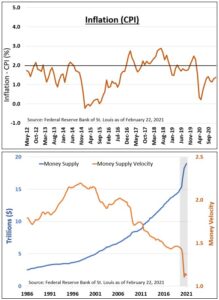 INFLATION! It seems “inflation” is the latest buzzword in the financial press, it must be a light news week. It appears the media even primed their talking heads to discuss inflation concerns in order to negatively sensationalize it. It’s almost as if the media wants to keep people emotionally charged to retain an audience. Since “inflation” is out there, let’s talk about it.
INFLATION! It seems “inflation” is the latest buzzword in the financial press, it must be a light news week. It appears the media even primed their talking heads to discuss inflation concerns in order to negatively sensationalize it. It’s almost as if the media wants to keep people emotionally charged to retain an audience. Since “inflation” is out there, let’s talk about it.
What are the current inflation levels?
Although there are different ways to measure inflation, the primary measure is the Consumer Price Index (CPI). The most recent CPI reading is 1.4%, far below the 2% target set by the Federal Reserve (The Fed). The Fed feels this is a good rate to spur economic activity without overheating it. As you can see from the inflation chart, the Fed has had difficulty even achieving the 2% target over the past decade.
Are there any underlying inflationary pressures?
Yes and no. Essentially, inflation is the price we pay as consumers. The two main inputs are the cost of raw goods and the labor to create goods and services. Some raw goods (copper, lumber, oil) have seen recent increases while others have not (milk, rice, cattle). Price inconsistency is fairly typical of early economic stages.
At the same time, labor has a long way to go, but huge strides have been made. The unemployment rate is currently at 6.3%, from a high of 14.8% just 10 months ago. Unemployment assistance has followed a similar pattern. Although such a quick recovery is atypical, there is still much room to go. In the end, ample slack in the labor market is not likely to allow businesses near-term pricing increases, in aggregate.
Is there an inflationary concern beyond raw goods and labor?
As a matter of fact, yes. The amount of available money (known as money supply) by the Fed is at all-time highs due to the massive infusions over the past 10 months. The problem is the pace which consumers spend money (known as velocity) has fallen off a cliff. No matter how much money is available, if it is not being exchanged, the economy can’t move forward. Velocity is like the transmission of a car. If the transmission is in neutral, no matter how much you push the accelerator, the car won’t move forward. However, if you shift the transmission in to drive while holding the accelerator, the car can violently launch forward. Therefore, inflation is not a given nor a likely near-term issue, but an aspect that requires monitoring.
Although boring to most, inflation is a foundational factor for financial markets, hence the media attention. However, the level of alarmist attention may be premature. As always, we monitor within our portfolio design and if warranted will make adjustments in the future. Enjoy you weekend, especially now that the North American polar vortex seems to have receded. Feel free to reach out if you have any questions.
CRN-3470495-022621


Recent Comments